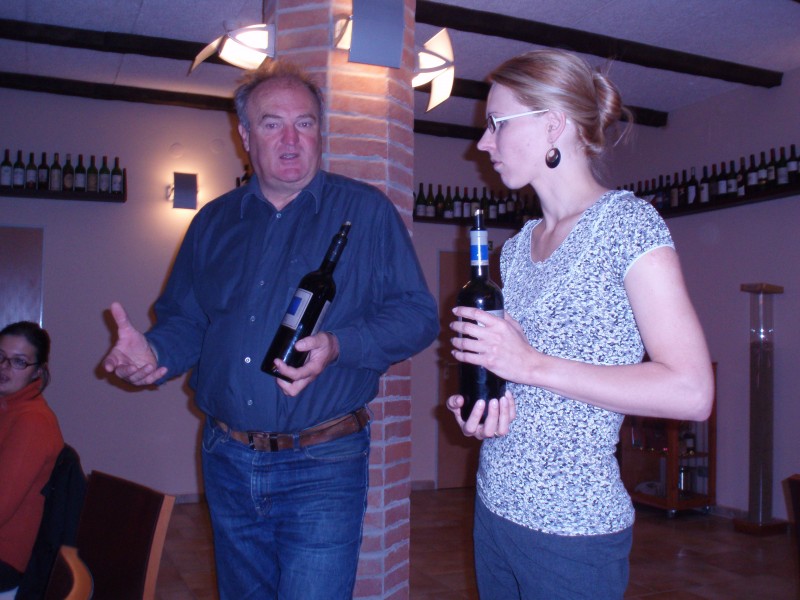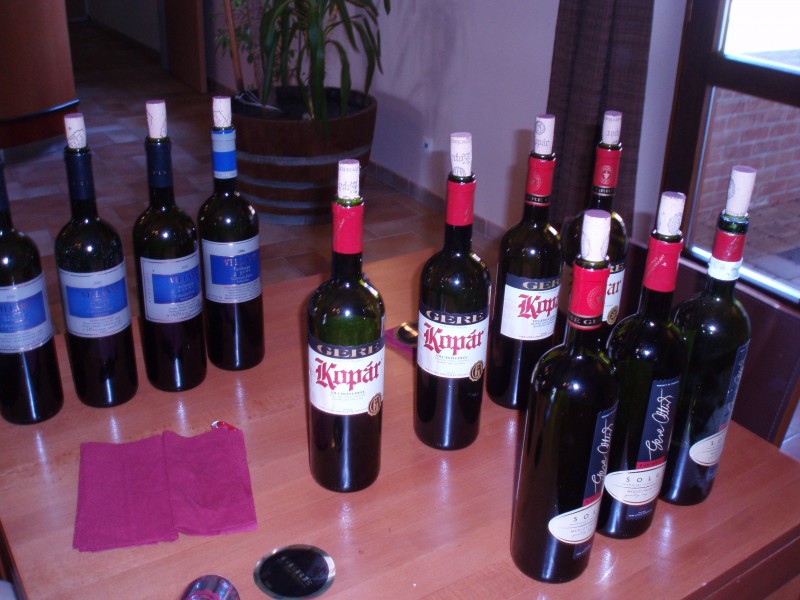Villány is in the south of Hungary near the Croatian border. When we arrived late at night I could see the lights across the border in Croatia from my hotel room. Our hotel was a small boutique-style establishment with a spa (which unfortunately we didn’t get to see). It is owned by the Gere family with whom our first and only visit in Villány was scheduled for the following morning. Their hotel is part of a wider attempt in some regions to encourage more wine tourism and although only recently opened and still being finished outside, seemed to be busy already.
The region of Villány-Siklós is one of Hungary’s best red-wine producing areas. Its most important vineyards are located in the villages of Villány, Villánykövesd, Kisharsány, Nagyharsrsány and Siklós. The Villány-Siklós wine region lies upon the south-eastern slopes of the Villány mountains. These mountains protect the vineyards from the cold northern climate resulting in a special sub-mediterranean local mesoclimate very suited to producing some fine red wines.
Attila Gere
On our first full day of the trip we visited the Gere winery, owned by one of the leading wine producers in Villány and based just outside the village of the same name. We were met and warmly welcomed by winemaker and owner Attila Gere and his daughter Andrea, who acted as translator.
Attila explained that the vines here at Gere are at an altitude of 150 to 250 metres on south, south-west facing slopes. Their plantings are almost all red varieties but they also have a tiny quantity of Olaszrizling (1ha). The soil here is loess which is rich in chalk pebbles and has good water retention properties, a factor which is very important in hot years.
These conditions seem to bring out the best in cabernet franc in particular; it is a long-standing variety here and became established after phylloxera. However, Attila feels it was only between 1997 and 1999 that winemakers here began to understand what quality wine means and the real importance of low yields.
Thankfully this was one of the visits where the room was laid out for a seated tasting (always easier for detailed note taking) and it was very professionally organised with individual spittoons and two glasses each for a vintage comparison (itself very welcome). We compared Cabernet Francs from 2000, 2002, 2003 and 2006 with the same vintages of Gere’s flagship wine, Kopar, which is a Cabernet Sauvignon, Cabernet Franc, Merlot blend.
The vintages:
2000 – A very hot vintage with high temperatures and little rain. In 2000 the average annual temperature was 13.3OC in Villány where this figure typically fluctuates between 10.5 and 11.2OC. Many 2000 wines have matured quite fast and the lesser wines, although very high in alcohol, are not expected to keep very well.
2002 – A good average year, hot but not extremely so.
Tasting
We started with four vintages of Gere Cabernet Franc.
Cabernet Franc 2000 This wine had a very dark ruby core with a slightly garnet rim. It was quite evolved on the nose with a slightly heady, VA note followed by smoke, dark plums and spice.
The initial attack was very smooth, round and appealing, with a soft velvety texture and vivid acidity towards the end. It was not a huge wine but not weak either; in fact it was very well balanced with an unforced and gentle style.
Cabernet Franc 2002 (14%) In appearance this was dark ruby with an opaque core and quite evolved rim. It was more closed on the nose initially, with smoke, spice and undertones of tomato plant & leafy notes.
On the palate it had a silky and smooth initial attack, quite rich in flavour with gravelly-textured tannins that were a little firm and drying on the finish.
Cabernet Franc 2003 This wine had an opaque, almost black core. On the nose it had smoky, dusty tomato leaf and plum notes together with some spice and alcohol. On the palate again it had a very smooth, round, silky texture with plum and smoke flavours but it was a mid-weight wine with more grippy, greener tannins and a slightly drying finish. Overall, it had a quite lush texture and good flavour intensity.
Cabernet Franc 2006 (14.5%) Attila told us that for this and more recent vintages they have reduced the amount of oak to allow the fruit to shine through more. This wine was matured 60% in 225 litre new oak barrels and 40% in 5000 litre oak barrels. The total production was 10,000 bottles.
In appearance, it had a very deep, opaque core with a narrow purple rim. The nose was super-clean, with biscuit notes and stylish oak dominating initially. At first the fruit was closed but on standing there emerged some very vivid blackcurrant and violet qualities underneath. The palate opened with a very smooth, silky, initial attack followed by a good weight of creamy oak, ripe plums, blackcurrant and spice underpinned by a vibrant, mouth-watering acidity. Overall this was a very stylish, pristine wine with a seductive silky texture, lovely weight and balance and refined tannins. It is still very young and needs at least another 5 years but it was the best of the range for me and I thought the change in oak regime was definitely a big step forward.
We then moved on to tasting four vintages of Gere’s flagship wine called Kopar, a Cabernet Sauvignon, Cabernet Franc, Merlot blend. Kopai is a hill on their most southern slopes and this wine is a selection of their best parcels from this site only.
Kopar Villány Cuvée 2000 (14%) 40% Cabernet Sauvignon, 20% Cabernet Franc and 40% Merlot.
This wine had an opaque black core with a very narrow garnet rim.
The nose was initially lifted but high-toned notes were followed by blackcurrant, leaf, earthy plum and spice.
It had a very, very, silky, melting texture with a smooth and harmonious mid-palate, revealing a beautifully balanced and textured wine with fine gravelly tannins. The texture has enormous appeal and is balanced by juicy acidity. On the palate it is a little held back with brooding dark fruits, coal and smoke notes dominating. There was plenty of life and vitality on the palate but the texture is seductive now.
Kopar Cuvée 2002 (14%) With a dark ruby core and a wider garnet rim, this looked more evolved than the 2000.
On the nose, tea leaf, spice and heady qualities dominated initially, and it was almost Barolo–like. This was followed by notes of plums, cedar, cream, spice and cinnamon which were not yet married together. On the palate the wine was much more taut, youthful and nervy with tangy mouth-watering acidity; it still had a very silky texture with firmer more upright but fine-textured tannins. The fruit is rather held back at present by the firm structure but the velvety texture is already appealing.
Kopar 2003 (14.5%) This had a very deep, opaque core with a narrow rim which was already garnet in tone.
On the nose, there were smoky, dusty plum notes with some earthiness and a slight balsamic VA note which evolved on standing to something closer to a savoury, dried herb note.
A smooth, silky, voluptuous texture was balanced by a very lively, vibrant acidity. It is a not overly rich but beautifully poised wine with fine gravelly textured tannins. The fruit is harder to pin down but there is a savoury herbal note with plums and leafy tones.
Kopar 2006 (14.5%) 52% Cabernet Franc, 46% Merlot and 2% Cabernet Sauvignon.
Attila told us that this wine represents a move in a new direction as there was a much higher proportion of Cabernet Franc in the blend and the percentage aged in small (225l) oak barrels has been reduced in favour of large (5000l) oak barrels to allow more of the fruit quality to shine through.
This wine had an opaque core with a narrow, youthful, purple rim. On nosing, it was super-clean with a pure fragrance of violet and dried roses although stylish new-oak notes dominate at present. There are ripe, bright plum and cherry notes underneath and a delicate, haunting fragrance that is found only on the best cabernet franc.
On the palate again this was a beautifully crafted wine, with a melting, silky texture and a rich juicy mid-palate contrasting a velvety texture with a vivid mouth-watering acidity which adds vivacity and brightness. The flavours were also of pristine fruit and showed great precision. The tannins were more upright on the finish as befits a young wine like this but were still very fine textured. The finish was long, firm but very fine – excellent. This wine stood out for me as the star of the group.
Photos & text © Susan Hulme MW 2008
© 2008 – 2012, Susan Hulme MW. All rights reserved.



